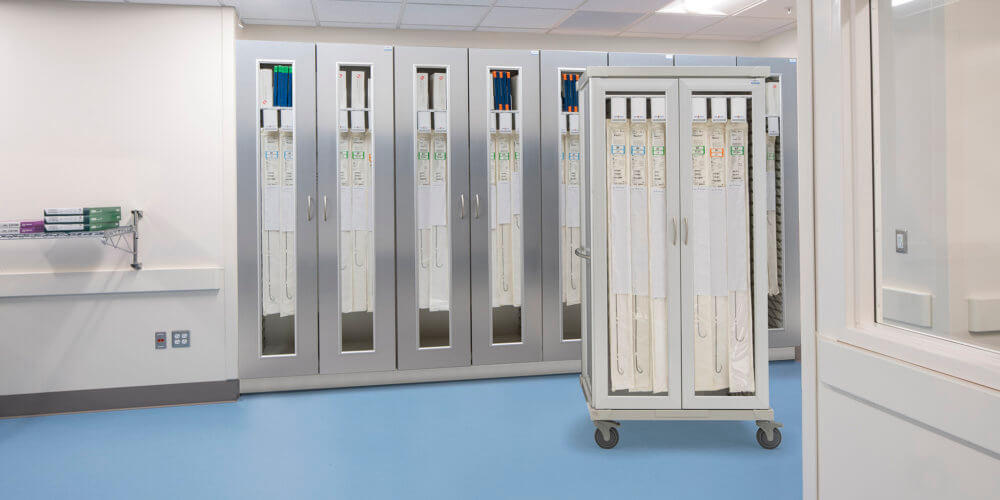A successful cardiac catheterization laboratory involves input from planners, managers, and staff. A united focus on patient safety, efficiency, and quality patient care can help guide the process.
This article will review 5 key considerations when planning a cardiac cath lab.

The Staff
According to Primary Angioplasty, the high-stress environment of a cath lab requires a team of specially-trained healthcare professionals. Cardiovascular and radiology technologists work with registered nurses to support the interventional cardiologist during cath lab procedures.
Staff should undergo continuing education that includes simulation drills and hands-on training during cath lab procedures. Ongoing education provides the knowledge and skills to respond to emergencies. Communication skills training helps staff develop good working relationships and realize better performance scores and optimal patient outcomes.
Cath Lab Design
Accessibility of services matters most when the clock is ticking. When choosing a location for the cath lab, designers should consider where the sickest patients enter the main facility (emergency room or helicopter pad). The cath lab should also be close to the operating room and cardiac units.
The procedure and control rooms should be situated so that the control room staff are elevated above the procedure room and have clear views of the patient from all angles.
Cath Lab Equipment
X-ray machines, a patient procedure table, monitors, procedure carts, lights, computer stations, and work stations for preparing medications are some of the equipment found in cath labs.
The procedures performed will determine the type of X-ray equipment installed in the procedure room. Cath lab technology companies continue to innovate, expanding into robotics, machine learning, and 3-D imaging without the risk of radiation exposure.
In addition to choosing equipment that embraces the newest technology, cath labs must also try to predict the future. Before purchasing X-ray and IT equipment, create a 5-year plan for the cath lab. Choosing equipment compatible with near-future advances in technology allows the cath lab to continue to provide the best quality care to patients while adding value to the original price of the lab.
Emergency equipment should be located nearby, including a code cart, defibrillator, CPR device, temporary pacing devices, and any other equipment that may be necessary.
Cath Lab Storage
Cath lab procedures sometimes require the administration of controlled substances, other medications, and IV solutions. Controlled substances are stored in a locked cabinet, and regulations may require a wall-mounted storage unit.
Catheters are stored in fixed or mobile hanging rack-style catheter cabinets designed to protect the equipment from contamination. Other devices such as stents, balloons, and vascular access sheaths are stored similarly in mobile or fixed cabinets.
Additional items can be stored in a room close to the cath lab to keep the area clear of unnecessary equipment and supplies.
When designing a cath lab, the Joint Commission requests that facilities refer to the American Society of Heating, Refrigerating and Air-Conditioning Engineers (ASHRAE) ventilation standards. The HVAC system should meet evidence-based guidelines that allow the storage of sterile supplies in an area free from fluctuations in temperature and humidity and contamination with excess moisture, dirt, or dust.
Quality Standards
Cath labs must meet the highest healthcare standards set by the industry.
A cath lab meets quality standards through accreditation and by joining industry quality improvement registries, according to the Catheterization and Cardiovascular Interventions report on the 2021 Society for Cardiovascular Angiography and Interventions (SCAI) updated guidelines on best practices in the cardiac cath lab.
Patient clinical outcomes must be tracked and documented, and this data is used to initiate improvements in processes. The SCAI outlines annual minimum facility and physician procedure numbers needed to meet requirements for clinical competence, and minimum staffing requirements depending on the procedure performed.
Providers must be credentialed under an accreditation body that requires periodic recertification. All staff must complete in-house continuing education, be ACLS or BLS certified, and should complete a cardiovascular specialty certification relevant to their position.
Cath lab technology continues to evolve at a rapid pace. Creating a cath lab that looks to the future is the best way to maximize ROI while providing safe, quality-focused procedures.
For assistance in storage planning for your cath lab, contact a representative at InnerSpace for more information.

Cindy Blye
Content WriterCindy Blye, BSN, RN, CCM is a Registered Nurse and Certified Case Manager. She is an Alumni of West Virginia University School of Nursing (BSN), and a member of the Association of Health Care Journalists and The Authors Guild.
Other resources utilized to research this article:
